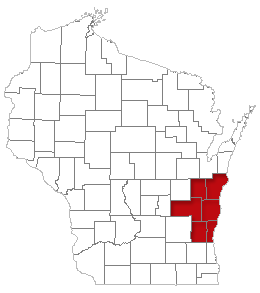The first dishwasher was invented in 1892. Weary of servants chipping and breaking her dishes, Josephine Cochrane rigged a copper pot with stiff brushes and a motor. It worked so well that she showed it at the 1893 Chicago World’s Fair — and won first prize! Today, most homes have a dishwasher. Unlike other appliances, the less you use it the more likely it is to break down. Water that remains in the bottom of your dishwasher is there for a reason; it keeps seals moist, to prevent leaks and protect the motor. When not used for long periods, the water evaporates, seals dry out and leaks and motor problems become likely. To prevent this, before a dishwasher sits unused for more than two or three weeks, pour in a half cup of liquid bleach (this prevents bacterial buildup). Then add 3 tablespoons of mineral oil. These coat the surface of the water and prevent evaporation — even over long periods of time. With a dishwasher, it’s “use it or lose it” — or protect it.
Preserving Holiday Greenery
Here’s a home brew to preserve the green and beauty of Christmas trees and to prolong the freshness of natural evergreen holiday decorations. To extend their natural beauty, mix a batch of this special holiday brew. First, go down to your local garden center and ask for miconized iron. Then add 1-quarter cup to 1 gallon of hot water. Also add 2 cups of light corn syrup and 4 teaspoons of chlorine bleach. This stuff is powerful and can stain carpets, so keep a plastic sheet spread underneath. Finally, trim an inch off the tree trunk and ends of stems, and add more brew as it evaporates. When the needles of other trees and greens are dropping left and right, yours will will be fresh and beautiful — right through the holidays.
Party Beverage Buying Tips
Planning a New Year’s Eve party? There’s a lot you’ll need to buy. A bottle of wine holds four to six glasses. Champagne, while the same in size, goes a bit farther. “Fifths” (4/5th- quart bottles) make from 10 to 16 cocktails. For mixes, get club soda, tonic and ginger ale, and have plenty of soda and soft drinks on hand, too. You’ll need 1 pound of ice per person. Sixteen people means 16 pounds of ice (you’ll want even more if you’re chilling bottles or cans). And, don’t forget juices like tomato, orange, apple and cranberry. Today many prefer juice and soda or sparkling mineral water to a cocktail. Don’t forget garnishes like lemon and lime, olives and bitters. To make 25 cups of coffee, you’ll need a half-pound and almost a gallon of water.
Organize Your Garage Into 6 Useful Zones
The garage– often the largest “room” in a home, but rarely the most organized. If you’re ashamed to open your garage door in front of the neighbors, consider the strategy below to organize and divide your garage into 6 useful zones.
Let’s pretend for a moment that you’ve already completed the hardest steps in organizing your garage. You’ve cleaned it out entirely. You’ve sold or thrown away everything except the items you actually use and need. You’re ready to put things back where they belong, and you’re determined to never let your garage fall into chaos and clutter again. How do you accomplish this seemingly impossible task?
As with any large space, the best way to organize (and stay organized) is to breakup the area into smaller zones– with each zone having a particular purpose.
1. First establish the transition area in your garage. Your transition area (generally near the entry door to the house) will be the space that’s reserved for hanging coats and taking off boots, with a spot to place packages, groceries or mail when you’re opening the door. This area will help you move easily from inside to outside and vice versa.
2. Next, determine the need it now zone. This zone (also generally located near the home entry door) is ideal for household overflow storage and will provide quick and easy access to the things you use often– dog food and leash, extra soft drinks, paper towels, small tools, and a place for recyclables.
3. Zone #3 is the area along your garage side-walls. Long, tall, thin items such as rakes, brooms, shovels and other tools can be stored here. A slotwall or pegboard system which employs a variety of hooks, baskets, and tool holders makes this often underutilized area useful again.
4. Large item storage is your next zone. Use this area for bulkier objects and for those items that can be kept out of the way for months at a time– like snow tires and camping equipment.
5. Frequently used items will be placed near the garage door. Items such as sports equipment and bicycles go here. Lawn and garden items such as bird seed, bug spray and lawn fertilizer can also be stored in this easy to access, convenient zone.
6. The final zone is your passion center. Make this the heart of your hobby area– reserved for working on what you love most. Whether you garden or fish, work with wood or work on your car, you can set up a perfect place in your garage that will provide the space for you to organize your tools and equipment. While the majority of your garage is dedicated to storage, this area is dedicated to you.
Now that you’ve cleaned, organized, and subdivided your garage space into 6 logical and useful zones, take a bow. Throw open that garage door and bask in the glow of admiring (and envious) neighbors. You deserve it!
By Chris Rasure
Measuring Drafts
The movie premier of Casablanca took place this day in 1942. At the end of the movie, Bogie got cold feet and sent Ingrid Bergman off into the misty night. If you’ve got cold feet at your casa, the culprit probably is outside air infiltration. You’d be amazed how much fuel a furnace consumes to warm the cold air that seeps into your rooms. Today you’ll learn about measuring drafts from chilly air leaks and tiny cracks. Here’s how: Starting in rooms you use the most, set a large outdoor thermometer down on the floor. Later check the temperature up near the ceiling. If the difference is 10 degrees or less, your room is fairly tight with regard to air leakage. If it’s higher, 15 to 20 degrees different or more, it’s time to start adding weatherstripping and caulk. For each room in your home, just “play it again, Sam.” Once you’ve plugged the leaks (and warmed your feet) you’ll notice fuel bills will be lower.
Incandescent or Fluorescent?
Thomas Edison, inventor of the phonograph, motion pictures and the light bulb, was born on this day in 1847. So today’s a good day to ask the question: “Should we still be using Edison’s incandescent bulb that heats a filament to 6,000 degrees or new compact fluorescent bulbs that burn cooler, use less energy and save money?” You be the judge. Compact fluorescents use 75 percent less energy and operate at one-fourth the cost. But don’t let low energy fool you. An 18-watt fluorescent gives the same amount of light as a 75-watt incandescent and lasts up to 10 times longer. They even offer three-level lighting and a low-watt 13-23-34 fluorescent gives the same light as a 50-100 and 150-watt bulb. Maybe it’s time to rethink. See the light and switch, because it seems somebody has come up with an illuminating alternative.
Home Heating System Tune-Up
With both air-conditioning- and heating systems, people, all too often, wait till they need them to find out they aren’t working right, or not working at all. You can avoid this by inspecting your system before the temperature drops — the sooner the better. Start by changing any dirty air filters. They make a furnace work harder and can be a fire hazard. Next, use a vacuum cleaner to remove any dust and debris from the fan area and burner chamber. With forced-air systems, check fan belt tension. It should give only about half an inch. Also check the burners to see if they work all right. Any black smudges around the access door are a telltale sign that an adjustment is needed. If you need help or have questions, call your local utility company or your neighborhood heating contractor. Then settle back and relax and let it blow, let it snow, let it blow.
Holiday House Lights
Are you one of those overachievers who puts up so many outdoor Christmas lights that jet planes think your house is a runway? Too much of a good thing can be a problem. Remember Chevy Chase’s house in National Lampoon’s Christmas Vacation?? In the movies decorating disasters are funny. At your house, safety is no laughing matter. Here are a few things you can do to make sure your holidays are beautiful and safe: First, never use indoor lights outside. Only use UL-approved exterior lights put up from below. Use a non-metallic ladder to prevent electric shocks. Stay off the roof to avoid falls and causing leaks. Suspend strands of lights from hangers rather than nailing or stapling them. The latter practice can cut into wires, creating shocks, shorts and hazards. And putting too many strands together can cause overheating, and cause a fire. Overloaded circuits can blow fuses and trip circuit-breakers. Just a little decorating common sense will make your home a beautiful and safe showplace this holiday season.
Ground Fault Circuit Interrupters – Part 2
Bathrooms can be dangerous places, but there are things you can do to make washing and bathing safer. In part II of our series on bathroom safety, we look at adding ground fault circuit interrupter electrical outlets to protect you from severe electric shocks. Many think circuit breakers and fuses accomplish this, but they are only “over-current” devices that protect wires from overheating and, in turn, protect the home from fire (but not people from electrocution). Electrocution is a real possibility with common duplex receptacles. To fix this, GFCI outlets monitor current, leaving the hot wire and current returning on the neutral wire. If it detects an imbalance, the device shuts down. GFCI outlets now are required in baths, kitchens (near plumbing), garages, outdoors and in any damp or wet location. Installing one is easy –there are just three wires to hook up. It’ll protect other receptacles downstream, too. The price won’t shock you either.
Glass Block Windows
Planning a remodeling project? Don’t overlook glass block windows. There are many styles and options from which to choose. There are attractive colors and patterns in plastic and glass — in individual blocks, kits and ready-to- install units for use in both windows and freestanding walls (in both straight and curved designs). Glass blocks are also energy-efficient. Much like double-pane thermal windows, they have a vacuum-filled space that insulates. Beyond their beauty, versatility and efficiency, they offer security against break-ins. Solid bulletproof glass blocks are available; they are virtually indestructible. There are inserts for ventilation, too. Looking for a hot remodeling idea, a cool design technique or privacy, security and energy savings? Don’t overlook glass block for windows and walls.






